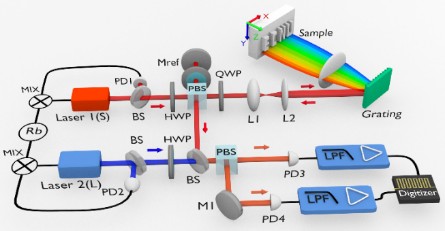Progress in dual optical frequency comb 3D rapid imaging technology based on spectral coding
[ China Instrument Network Instrument Development ] Optical frequency comb has ultra-fast time resolution and ultra-high frequency accuracy, which provides a larger platform for researching and exploring natural laws. After more than ten years of exhibition, it has become a precision spectrum measurement and foundation. An ideal source of frontier science such as physical constant determination, astronomical measurement, and quantum optics manipulation.

Dual optical frequency comb 3D rapid imaging experimental device diagram
Thanks to the rapid development of optical frequency combs, various scientific fields have advanced rapidly and many new measurement techniques have been produced. Among them, the dual optical frequency comb measurement technology has attracted wide attention as a revolutionary measurement method. It uses a high-factor down conversion factor to convert high-frequency optical frequency information into a radio frequency band that can be recognized by ordinary detectors, improving measurement accuracy while greatly reducing spectral sampling time. It is different from traditional Fourier transform measurement technology, has high-speed measurement, no complex mechanical scanning, wide band and high resolution. It was first proposed in 2002 and is widely used as an efficient measuring tool for precision spectroscopy. Measurement, absolute distance measurement, chemical sensing, nonlinear spectral imaging, and dissipative wave detection. With the development of technology, combining with more laser technologies to expand the application field has become an important development trend of the dual optical frequency comb measurement technology.
Recently, Li Wenxue's research group of the laboratory carried out a 3D fast imaging study based on spectral encoding for dual optical frequency combs. The combination of dual optical frequency comb measurement technology, one-dimensional spectral coding technology and optical reference technology realized absolute distance and sample 2D. Fast simultaneous acquisition of reflectance images and 3D topographic images. Both laser sources are broadband mode-locked pulsed lasers with slightly different repetition rates as signal sources and local sources. Different from the single-point ranging system, using the spectral encoding technology, the probe light is uniformly spread out in space through the dispersive element, and a one-dimensional line array is formed at the focal plane of the lens, and each frequency component forms a one-to-one correspondence with the spatial position. Through surface reflection, reflectance and depth information at different locations of the sample can be encoded into the amplitude and phase of different frequency components. Generally, the optical frequency comb has a frequency component of up to 105. This technique can realize single-time multi-point sample information loading detection, and effectively improve the imaging speed.
The optical frequency spectrum after loading the sample information is converted into the radio frequency band by the dual optical frequency comb technique, and then detected by the ordinary detector, and the plurality of information of the sample can be inverted by the comparison of the optical reference arm. Firstly, the absolute distance information is calculated by the time-of-flight method. The measurement accuracy can reach 159 nm under the average time of 1 s. Secondly, the one-dimensional reflectance curve and depth curve of the sample can be obtained by inversion of the amplitude and phase information of different frequency components. One-dimensional mechanical scanning of the axis can obtain an undistorted 2D reflectance image and a 3D topographic image of a 2.28 mm × 1.8 mm large target surface. The corresponding data stream time is only 252ms, which opens up a new path for fast topography imaging. Related research results are published in Opt. Lett. 43, 1606 (2018).
(Original title: Research on 3D fast imaging technology based on spectral encoding for dual optical frequency comb)
Below different plastic waste could be recycled into diesel:
Plastic pipes, plastic films, farm films, nylon, plastic convenient bags, HDPE bottles, bottle caps, food packaging...etc.
Different waste plastic has different oil yield and different oil quality.
If want to get diesel, need set up Plastic Pyrolysis Equipment and Distillation Equipment.
Plastic Pyrolysis Equipment
Used Tire Pyrolysis Equipment Plastic,Plastic Pyrolysis Equipment,Pyrolysis Of Plastic,Automatic Used Plastic Pyrolysis equipment
Shangqiu Zhongming Eco-Friendly Equipment Co., Ltd. , https://www.sqzhongminggroup.com